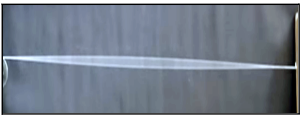Waves on a string
A string of mass per unit length $\mu$ is under tension $T$. The speed of a wave travelling on this string is given by \begin{align} v=\sqrt{\frac{T}{\mu}}. \end{align}
Two similar waves travelling in the opposite direction produces standing waves. The displacement of superposed wave is zero at the nodes and it is the maximum at the antinodes.
Stationary waves on a string fixed at both ends
Consider a string of length $L$ fixed at the both ends. The wave displacement at the both ends is zero. This is given by boundary conditions: $y=0 \text{ at } x=0 \text{ and at } x=L$.
The frequencies allowed on this string are given by conditions \begin{align} L&=n\frac{\lambda}{2},\\ \nu&=\frac{n}{2L}\sqrt{\frac{T}{\mu}},\\ n&=1,2,3,\ldots. \end{align}
The fundamental or 1st harmonics is given by \begin{align} \nu_0=\frac{1}{2L}\sqrt{\frac{T}{\mu}} \end{align}
1st overtone of 2nd harmonics is given by \begin{align} \nu_1=\frac{2}{2L}\sqrt{\frac{T}{\mu}} \end{align}
2nd overtone of 3rd harmonics is given by \begin{align} \nu_2=\frac{3}{2L}\sqrt{\frac{T}{\mu}} \end{align}
All harmonics are present in a string fixed at the both ends.
Sonometer is a string fixed at the both ends. Following are useful relations for a sonometer \begin{align} \nu & \propto \frac{1}{L} \\ \nu & \propto \sqrt{T} \\ \nu &\propto \frac{1}{\sqrt{\mu}} \\ \nu & =\frac{n}{2L}\sqrt{\frac{T}{\mu}} \end{align}
Stationary waves on a string fixed at one end
Consider a string of length $L$ fixed at one end and free at the other end. The wave displacement at the fixed end is zero. This is given by boundary conditions: $y=0 \text{ at } x=0$.
The frequencies allowed on this string are given by conditions \begin{align} L & =(2n+1)\frac{\lambda}{4}\\ \nu &=\frac{2n+1}{4L}\sqrt{\frac{T}{\mu}} \\ n&=0,1,2,\ldots \end{align}
The fundamental or 1st harmonics is given by \begin{align} \nu_0=\frac{1}{4L}\sqrt{\frac{T}{\mu}} \end{align}
1st overtone of 3rd harmonics is given by \begin{align} \nu_1=\frac{3}{4L}\sqrt{\frac{T}{\mu}} \end{align}
2nd overtone of 5th harmonics is given by \begin{align} \nu_2=\frac{5}{4L}\sqrt{\frac{T}{\mu}} \end{align}
Only odd harmonics are present in a string fixed at one end.
Questions
Question 1: A string is fixed at the two ends. The fundamental frequency is $\nu_0$. The string is plucked at the middle and then released. Mark the correct statement.

- The string will vibrate in fundamental mode with a unique frequency $\nu_0$.
- The vibration will be a superposition of modes with frequencies mainly $\nu_0, 2\nu_0, 3\nu_0$.
- The vibration will be a superposition of modes with frequencies mainly $\nu_0, 3\nu_0, 5\nu_0$.
Question 2 The figure shown is an actual photograph of a string vibrating in its fundamental mode. Explain why the edges of the figure are sharper then the middle portion.

Problems from IIT JEE
Problem (IIT JEE 2000): Two vibrating strings of the same material but of lengths $L$ and $2L$ have radii $2r$ and $r$ respectively. They are stretched under the same tension. Both the strings vibrate in their fundamental modes, the one of length $L$ with frequency $\nu_1$ and the other with frequency $\nu_2$. The ratio $\nu_1/\nu_2$ is given by,
- $2$
- $4$
- $8$
- $1$
Solution: Let the lengths and radii of the two strings be $l_1=L$, $r_1=2r$, $l_2=2L$, and $r_2=r$, respectively. Let $\rho$ be the density of the material. The mass and mass per unit length of the first string are, \begin{align} m_1 &=\rho (\pi r_1^2 l_1) \\ &=4\pi \rho r^2 L,\\ \mu_1&=\frac{m_1}{l_1}=4\pi \rho r^2, \end{align} and that of the second string are, \begin{align} m_2&=\rho (\pi r_2^2 l_2) \\ &=2\pi \rho r^2 L, \\ \mu_2 & =\frac{m_2}{l_2}=\pi \rho r^2. \end{align} In fundamental mode, $l=\lambda/2=v/(2\nu)$ which gives, \begin{align} \nu=\frac{v}{2l}=\frac{1}{2l}\sqrt{\frac{T}{\mu}}. \end{align} Substitute $\mu$ from first and second equation to get, \begin{align} \nu_1&=\frac{1}{2l_1}\sqrt{\frac{T_1}{\mu_1}} \\ &=\frac{1}{2L}\sqrt{\frac{T}{4\pi\rho r^2}} \\ &=\frac{1}{4L}\sqrt{\frac{T}{\pi\rho r^2}},\nonumber\\ \nu_2 & =\frac{1}{2l_2}\sqrt{\frac{T_2}{\mu_2}} \\ &=\frac{1}{2(2L)}\sqrt{\frac{T}{\pi\rho r^2}} \\ &=\frac{1}{4L}\sqrt{\frac{T}{\pi\rho r^2}}.\nonumber \end{align}
